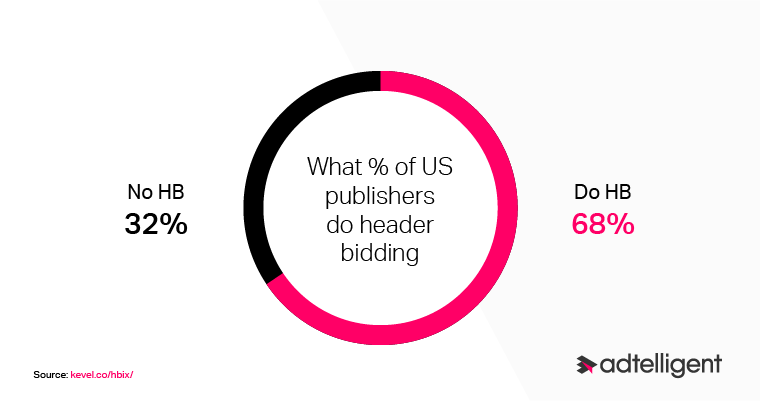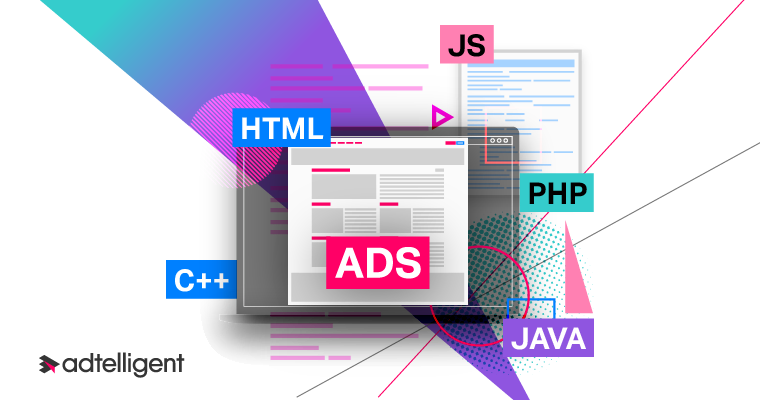The rules of the digital world change constantly; it is especially noticeable in recent years after the string of Internet privacy scandals and debates over the ethics of the digital realm. With the fast speed of technological advancement, it is no wonder that numerous transformations take place online every day. Therefore, it has become essential for any online business to keep up to have a substantial chance of succeeding and beating the competition.
The online marketing and advertising department is no exception to this rule. For instance, the recent unveiling of Google’s Core Web Vitals (CWV) scores has emphasized the page load speed and UX, so marketers have to adjust to new realities.
Under such circumstances, it is essential to make sure that content, especially ads, is loaded swiftly and without any issues. However, while many marketers, 68% of US publishers use Header Bidding technology, not many people know about Footer Bidding. This new exciting feature can boost such crucial factors as user experience and website speed.

So what exactly does footer biding stand for, and how to implement it? First, let’s figure out the basics and see what this technology is.
WTF is footer bidding?
Before diving into footer bidding explanation, we need to briefly describe the mechanics behind header bidding.
Header bidding wrapper’s code (Javascript) is integrated into the website’s header and ensures that advertising auctioning starts in parallel to the page load. Sometimes it can decrease page-load speed, precisely due to the mechanics of the technology, namely the simultaneous load of ads and other content on the webpage. Considering new Google’s CWV metrics, page latency can be a major bad influence from now on.
Footer Bidding does not support any ad requests until the point when the page’s content is fully loaded. Then, it starts the auction, not during the content load, but after everything is loaded completely. The name of the feature (Footer) refers to the mechanism mentioned above that is the opposite of what header bidding does; however, the wrapper code is still placed in the website’s header.

There are numerous advantages of such an approach, and there are some drawbacks, as per usual:
Pros of footer bidding
- Better UX: Under current circumstances, maintaining a proper level of UX is a must. It is important for good rankings; it is also important for supporting fruitful relationships with webpage visitors. No one wants to wait for content to load, so if it loads at the very beginning – there are better chances of a higher engagement level.
- Simple Ad Layout Control: This point is especially relevant for web sources with many types of different ad layouts and ad units. Loading ads that are not present on the page can cause viewability metrics to drop. It can be avoided by running the JavaScript check and seeing which ads are on the page. The risk here is running the check too early, in which case the script might not detect an ad unit that will appear on the page later on. Footer bidding solves this issue by implementing ad-related scripts solely after the page is fully loaded.
- Improved SEO: Fast-loading content and more users engaging with your website can be a major SEO improvement, which is essential these days. Footer bidding takes care of both of these issues.
- More demand partners: Another positive side-effect of footer bidding is that marketers are not limited to a certain amount of bidders because the page has already loaded. Better CPMs can be achieved by adding more demand partners as bidding happens after the page load.
Cons of footer bidding
- The possibility of a late ad loading: Due to the nature of footer bidding, there is a possibility that the ads might load late. It leaves ads in the page’s header vulnerable, as the user might have already scrolled down before the ad was loaded. It isn’t good for monetization.
- Not good for sites that haven’t been optimized: The issues with the page’s speed are crucial if you want to implement and benefit from footer bidding. Considering the previous point, it is crystal clear that the technology will do more harm than good under bad speed optimization. It should not be integrated if a website has preexisting loading issues.
- Decreased viewability: Footer bidding won’t be a good idea if most of the ad spots are located on top of the main content or above the fold. Implementation of the technology increases the chances of the viewability drop, especially if there are additional issues with page latency. There’s a significant chance to drop viewability for these ads or placements if your page doesn’t load fast.
- Excessive control is needed: Another issue with footer bidding is the flexibility of the controlling options. For instance, if the site runs on WordPress, you have little control over the times when different parts of the page should be loaded. It simply won’t allow for a proper calibrating of the technology, and footer bidding will not bring any profits.
How to set up footer bidding?
To take advantage of the footer bidding, one must already have header bidding integration on their site and be familiar with JavaScript. We won’t go into many details, but there are a few things to look out for during the implementation process. In addition, some strategies can help you take advantage of the technology’s potential in full capacity.
Useful strategies before adding footer bidding
Several things should be checked before the footer bidding code is integratеd.
1. Page Load Speed
It is better to know your window load event speed to avoid the problems mentioned above connected with the page load speed ahead of the integration. Go to Page Speed Insights, check if any asset needs reassessment.
2. Lazy-load images / Embedded content
Having lazy-load images is a good idea in the context of footer bidding potential implementation as they can help significantly decrease the time to load the content. You can use one of the numerous JavaScript libraries or a plugin to lazy-load the visual content on the page. The same can be done with embedded content such as Youtube videos, iframes, Sketchfab 3D objects, etc. Again, there are a lot of plugins available for such purposes; you just need to make sure they have the “data-src” attribute instead of the “src” one.
3. Image optimization
To maximize the footer bidding effect, it can be useful to minimize the size of images for fast loading sake. Numerous services can do it, such as Gumlet, Kraken.io, or Smush.
4. Delay scripts / CSS
Another aspect of paying attention to is the loading of non-essential scripts. It is better to postpone such content until the page is loaded completely. Such scripts as anti-AdBlock solutions or Google Analytics etc. can be set aside in favor of speed optimization.
Cascading Style Sheets (CSS) and all related items can be moved to the lower part of the page and delay their load until the rest of the page is fully loaded. It can be done through deferring scripts and native “defer” HTML attributes or through JavaScript. If you work on WordPress, there are several solutions and plugins available specifically for these purposes.
5. Additional speed improvements
The following measures might seem excessive, but we highly recommend employing them as well. We suggest using any type of Content Delivery Network or CDN like Cloudflare, Fastly StackPath, or any other one. It is more effective for static assets to be cached with the HTTP headers so you can serve fully cached static HTML to users who aren’t logged in, and those who are logged in will be redirected to a subdomain with turned off cashing. Speed load is the key to success, so make sure to do absolutely everything in your power to improve it to the max.
Ad Loading Improvement
Publishers who are thinking about implementing footer bidding should take care of a swift ad loading. You need to ensure that every code is loaded in the right turn and the user’s browser is prepared to engage with the demand partners.
1. Loading Critical Resources Early
To achieve the goals mentioned above, we need to preload, DNS-prefetch, and preconnect directives:
- Send a preload directive in HTTP headers to the browser so core JavaScript functions and ad code can be loaded right away before the HTML is downloaded.
- Send preload directives in HTML header for Google Ad Manager and Amazon TAM’s JavaScript libraries.
- Preconnect directives in the HTML to connect beforehand to header bidding wrapper, if it is hosted separately, and to all header bidding partners to get bids as fast as possible.
2. Setting Load Timeout
There can be cases when the page load speed is not at its best, and some content simply would not load. With footer bidding logic, the auction will not start at all – as the content technically still isn’t fully loaded. To negate this problem, you can set a timeout of a few seconds from when the load of the pages is triggered. In this way, the auction runs anyway when the time limit is reached, despite some content’s stagnating loading speed.
3. Help with CMP, CCPA, and Tracking Pixels
The nature of footer bidding ensures that any kind of consent management solution (CPM) like GDPR or CCPA and others will be fully loaded by the time ads run. The same principle also stands for tracking pixels. This can be a tremendous help in navigating new consent-based digital reality as it directly helps to adhere to new privacy-oriented rules.
Test flight
After carrying out any kind of changes to the system, simple checks or a/b testing are essential. They help to see whether the implementation is effective and, if not, which aspects can be improved. It applies in the case of header bidding to the footer bidding switch as well. The best strategy is to start from most general changes, noting the results, then applying more precise settings, playing footer bidding abilities, and seeing the outcomes.
It is good to first run a solution and see how it impacts revenue and the number of ad impressions. You can also play with the number of demand partners, as footer bidding allows you to call more of them. Then, monitor the revenue stream before and after these changes.
Checking page speed metrics before and after footer bidding can also give valuable insights into its impact on the page latency and evaluate the level of engagement. Lazy-loading content can also be tested separately.
Key Takeaways
In this article, we described footer bidding technology and how it can affect publishers’ monetization efforts. The fundamental takeaway is realizing that technology can help or hurt these efforts if integrated improperly and without considering additional factors.
If you want to switch to footer bidding and get the most benefits out of it, you need to properly evaluate all of the factors mentioned above. However, when implemented properly, it can be a valuable addition to your monetization strategy that is especially relevant in the wake of changing Google’s Core Web Vital rankings.